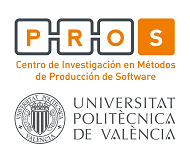Amino Workshop Timetable (10th of November)
| Amino Workshop |
On the Role of Enterprise Modelling in Engineering Cyber-Physical Systems
Kurt Sandkuhl
Cyber-Physical Systems (CPS) are considered as key elements of the next industrial revolution which have an enormous innovation potential. However, the existing gap between methods, modelling approaches and viewpoints of the disciplines involved in CPS development creates significant difficulties for creating viable CPS solutions. In this contribution we investigate the potential of using enterprise modelling as an integrative method for large parts of CPS development projects. The work is based on a case study from transportation industry. The main contents of this contribution are (1) a case study from transportation illustrating CPS development with business and technical aspects, (2) a discussion of enterprise modelling potential in different development phases of CPS, and (3) a proposal for a CPS development process integrating technical and business aspects.
Building Sustainable Applications by Integrating Capability-oriented Enterprise Modelling with System Development
Jelena Zdravkovic, Janis Stirna
A significant objective of today’s enterprise Information Systems (IS) is to be sustainable, which entails producing value to their stakeholders over time. A major concern is how Information Systems can successfully adapt according to and support constant variations in business conditions originating, for instance, from changes in customers’ demand, environmental aspects, regulations, and many others. The need for enterprises to operate in changing environments has been addressed by proposing a capability-oriented approach that integrates organizational development with IS development taking into account changes in the application context of the solution. This is referred to as Capability Driven Development (CDD). It requires a number of organizational concepts to be modelled, such as business goals, processes, resources, Key Performance Indicators (KPIs), as well as the parameters for describing business environmental contexts for organizations capabilities. In our presentation we intend to outline the CDD approach for supporting model-driven organisations, present the current experiences of developing capability models in several organizations, as well as to demonstrate the use of the key components of the CDD Environment at a real-world industrial case.
The impact of cloud computing on the future of enterprise modeling. About datalogical, infological and ontological models in the cloud
Peter Zencke
Cloud Computing with SaaS as a disruptive technology has the potential to fully transform the ICT industry. While cloud computing with the operational efficiency of mega datacenter makes the usage of enterprise systems affordable for small and midsize enterprises and eliminates the cost of many traditional IT related services, the business adaptability of SaaS solutions is still at an infant stage. Most SaaS solutions treat all their tenants as equal allowing very limited customization. In a business environment where enterprises have to strive for competitive differentiation, this limitation for broad adoption of enterprise SaaS has to get resolved.
In Enterprise Engineering the separation of concern of different modeling views is state of the art. The three most important enterprise model views are datalogical, infological and ontological models. For SaaS enterprise solutions these three views have to become independent model layers with clear separated ownership as well. The datalogical layer will be a shared layer for all enterprise tenants using the same Big Data infrastructure of non relational high performance data services. The infological layer will interact with the same dataservices eliminating the redundancy of separate transactional and analytical data storages. Infological views in cloud computing are mostly computed at run time driven by an active infological repository individually owned by the SaaS tenants. The ontological model representing the enterprise organizational structure with its activities and processes even more has to be in full ownership of each tenant consuming an enterprise solution as a service. Thus ontological models become a crucial layer in SaaS enterprise solutions allowing for competitive differentiation of enterprises in the cloud.
A Model-Driven Perspective to Go from Requirements to Code
Oscar Pastor
A crucial success factor in information systems development is the alignment of the system with business goals, business semantics and business processes. A key point is to provided software production environment that support the subsequent correct transformations through the use of the adequate conceptual models. Developers should be freed from programming concerns and being able to concentrate on these alignment problems. Model-driven system development (MDD) not only provides a structured and systematic approach to systems development, but also offers developers the possibility of using model transformation technologies to derive models of a lower abstraction level that can be further refined, and even generate software code automatically. From the experience got with the advanced MDD platform provided by Integranova, this talk will show how to successfully integrate business process modelling (BPM), requirements engineering (RE) and object-oriented conceptual modelling with the objective of leveraging MDD capabilities. The current state of the art on modelling methods and code generation tools will be discussed to explore different ways to match an information system with business requirements. Concrete principles, concepts and common practices of MDD will be presented with a special focus on model-driven requirements engineering, meaning by it how business process models and requirements models can be embedded in a complete MDD process.
Combining top-down and bottom-up modeling for Agile Enterprises
John Krogstie
Whereas Enterprise Modeling and Enterprise Architecture often is looked upon as top-down, conservative approaches to organizational development, we will argue that they can function as good frameworks for long-term developments and organizational innovation, as long as they are combined with bottom-up approaches tapping directly into the knowledge of the workers. In the talk we will discuss how active knowledge models and interactive models that are meant to be evolved directly by workers can be combined with more traditional enterprise architecture frameworks to support agile enterprise development.
Abstraction, composition, and separation of concern in architecture
Ulrik Franke, Mika Cohen
Abstraction, composition, and separation of concern are fundamental to architec-ture: an architecture is a consistent collection of views that deconstruct a system by means of abstraction-realisation, composition-decomposition and separation of concern (cf. [1, 2]). There seems to be considerable confusion, however, within the architecture community as to how these concepts relate to each other. Does composition-decomposition lead to a separation of concern? Many authors claim so (cf. [4, 5]). Does abstraction-realisation similarly lead to a separation of concern? Again, several authors suggest this (cf. [3, 4]). However, these questions have not, as far as we are aware, been explored in a detailed, formal manner in the literature.
Model-enabled design in organisations
Erik Proper
In this presentation we will at the enabling role of models for design in organisations (and their enterprises). We specifically look at modelling “in organisations” and not only “of organisations”. We will argue that the design of an organisation is an activity that takes places naturally throughout organisations; sometimes following a top-down path, but more often than not in a bottom-up way. We then turn to the potential enabling role of models in the context of these (re)design processes. Based on this we then identify possible challenges for the use of models in design activities, in particular when there is a need to direct/coordinate these activities. In doing so, we will base this on earlier experiences (in research and practice) with enterprise architecture and enterprise engineering.
A few thoughts on the notion of 'Model Driven Organisation'
Stefan Strecker
In this short talk, I put up a few thoughts for discussion I consider important with respect to forming a critical view of using conceptual models for the purposes stated in the definition of the 'Model Driven Organization' (MDO). My largely non-surprising arguments mainly resort to organisational theory literature, and point to a number of viewpoints critical of the notion of designing and engineering an organisation.
Realizing Analyses and Simulations of Enterprise Models Using Semantic Annotations
Hans-Georg Fill
In model-driven organizations enterprise models are used to represent and analyze the current and future states of aspects such as strategies, business processes or the enterprise architecture. Thereby, algorithmic analyses and simulations contribute to an increased value of such models. However, the application of such algorithms often requires the existence of information in particular formats, which may not be provided a-priori by the underlying modeling method. As a solution approach, semantic annotations of models and meta models may be used to dynamically apply analysis and simulation services. In this way, a loose coupling between information represented in models and information required by algorithms is achieved. For illustrating the approach we present examples from the fields of risk management, semantic obfuscation, and business process benchmarking.
The Role of Models for Organisations and Software Systems: Conflicting Goals and Prospects
Ulrich Frank
The fields of software engineering and organisational design are clearly separated: different communities with different languages and different research agendas. However, a closer look at essential issues reveals interesting commonalities that both fields share with philosophy. There are similar design goals, similar design principles – and corresponding conflicts, if not contradictions that need to be accounted for. A few of these conflicts will be demonstrated. Then principal strategies to relax these conflicts will be discussed. Against this background it will be outlined how modelling languages and respective models could be constructed to follow these strategies.









